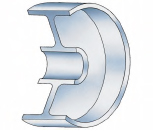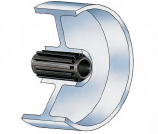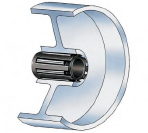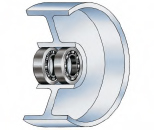
CHOOSE THE RIGHT WHEEL
Choose the right wheel is not an hard process as you might think.
You have to pay attention to some aspects involving the uses of the wheel.
The technical features and the resistance of each material generates different performance depending on the type of wheel and type of use.
A first consideration is the type of fixation of the wheel to the instruments, choosing between wheels alone and swivel or fixed castors. The difference is that the swivel castor is adjustable according to the movement, while the fixed castor is locked in the moving direction of the wheels. Also, the castors can be realized through different solutions: plate with holes, center hole, threaded or smooth stern, rubber expanders .
The second aspect to consider is the weight that the wheel will have to carry: the load capacity of a wheel is calculated from the weight of the equipment to transport including load and then dividing by the number of wheels used.
Now consider the material that best suits the type of use you have in mind. In fact the hardness, the shape and the material in which the wheel is coated affect the fluency, the noise level, the force required to push, the resistance to rotation and the protection of the surfaces. Always choose a coating of the wheel that is softer to the surface above which will have to operate, to avoid damages or traces.
Than consider the type of maneuverability you want to get from the wheel: the maneuverability of an instrument is influenced by the number, the type and arrangement of the wheels. The rolling resistance of the wheel is also affected by various aspects: the material in which it is coated , the diameter , the load that has to carry and the conformation of the surface with which it is in contact. The greater the resistance the greater the thrust force that must impart to the load to be able to move.
Another important aspect is the system rotation of the wheel, which influences the sliding together with the load, the pushing speed, environmental conditions and the force exerted to move the object.
These are the type of rotation systems:
HUB WITH PLAIN BORE

The hub with plain bore represent the simplest type of hub, and are characterized by strength and humidity resistance, but have higher values of friction and therefore imply a majeure pushing force.
HUB WITH BUSH

The hub with bush is indicated for medium load and needs a periodic lubrication that ensures a good flow and lower coefficient of friction than the hub with plain bore.
ROLLER BEARING

The roller bearings are characterized by strength and needs a lower pushing force to move the load.
BALL BEARING

The ball bearings gives excellent performances and are the best solution for high speeds. They are also highly sliding and resistance to medium and high loads.
Finally, consider the type of flooring and the environmental conditions in which it will operate the wheel. Simply check the type of ideal surfaces for each wheel's series, taking into account that the wheels of the professional series operates also in hard surfaces. The furnishing wheels series are particularly suitable for fragile surfaces because their coating doesn't damage or leaves traces on the flooring.